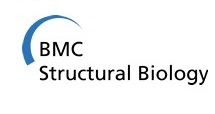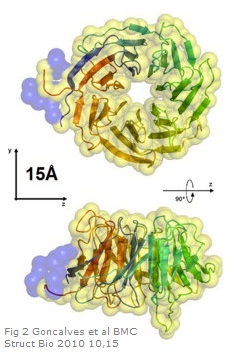 Despite their name, biological macromolecules are actually pretty small, and it can be tough determining their structure. Many techniques have been developed over the last century to bypass the limits of conventional light microscopy, to peer deeper into the shapes and functions of key molecules like proteins and nucleic acids.
Despite their name, biological macromolecules are actually pretty small, and it can be tough determining their structure. Many techniques have been developed over the last century to bypass the limits of conventional light microscopy, to peer deeper into the shapes and functions of key molecules like proteins and nucleic acids.
Determining with accuracy the exact shapes of these molecules is crucial if we are to gain an understanding of just how interactions in this giant molecular jigsaw maintain the essential biological processes of life.
 One promising approach is Small-Angle Scattering (SAS). This technique of low-resolution analysis utilises high-powered X-ray or neutron beams fired at samples from a synchrotron source (similar to the Large Hadron Collider) or nuclear reactor to reconstruct the shape of molecules from the shadow left behind after the beam passes through.
One promising approach is Small-Angle Scattering (SAS). This technique of low-resolution analysis utilises high-powered X-ray or neutron beams fired at samples from a synchrotron source (similar to the Large Hadron Collider) or nuclear reactor to reconstruct the shape of molecules from the shadow left behind after the beam passes through.
Unlike long-established high-resolution techniques like crystallography,SAS is able to probe the shapes of macromolecules in solution, rather than requiring fixation within a solid crystal. This means that molecules can be studied in more biologically realistic conditions, and without having to wait for samples to crystallize.
However, until now SAS has yet to establish a publication framework emphasising quality assurance to help guide researchers—something that was crucial to the scientific development of these other fields.
In a Commentary article published today in BMC Structural Biology, Professor Jill Trewhella and colleagues outline the guidelines recently drawn up by The International Union of Crystallography (IUCr) for the reporting of data derived from SAS studies, and discuss why such a framework is necessary for the development and establishment of this emerging technique. This compliments nicely a recent exposition of these guidelines from the same group, and an accompanying piece by Edward Baker and Zbigniew Dauter on the future of the field.
This is the first of a number of articles to be published in BMC Structural Biology focusing on developments in the analysis of biological macromoleculesusing SAS techniques, co-ordinated by Section Editor Paul Ramsland and deputy Section Editor Cy Jeffries. A forthcoming Review from the lab of Andrej Sali highlights recent advances in the development of computational methods using SAXS profiles (from an X-ray source), and how these can be integrated into theoretical models for enhanced accuracy in structure prediction.
BMC Structural Biology would like to issue an open invitation to all researchers working in the field of structure determination using SAS techniques to get in touch and get involved– we would be delighted to consider your contribution to this exciting field.
- A shock of change felt down the generations - 20th February 2014
- BMC Ecology launches its 2014 Image Competition - 13th February 2014
- Clever camouflage and "riotously coloured floral genitalia": it's the winners of the BMC Ecology Image Competition - 22nd March 2013
Comments